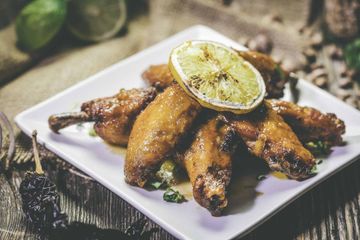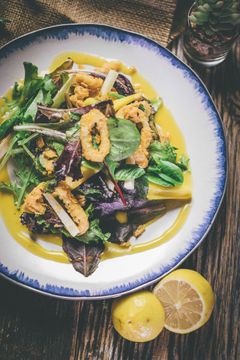Discover why churros are everyone’s favorite after every Mexican meal
Discover the Rich Flavors of Mexican Food: A Trip Through Its Popular Cuisines
Mexican cuisine supplies a tapestry of tastes and traditions that mirror its rich social heritage. Each meal, from the beloved tacos to the elaborate mole, lugs its very own story and relevance. The diverse components and cooking techniques highlight local variants and common eating experiences. As one checks out these prominent meals, the depth and variety of this culinary landscape ended up being significantly evident, welcoming interest regarding what lies beyond the surface area of these legendary flavors.
Tacos: The Quintessential Mexican Road Food
Tacos, typically related to as the quintessential Mexican street food, personify the rich cooking practices of Mexico. These savory creations include a crunchy or soft tortilla loaded with a range of active ingredients, showcasing a range of tastes and textures. From tasty meats like carnitas and al priest to vegetarian choices including beans, cheese, or grilled vegetables, tacos provide something for every taste buds.
The simpleness of the taco permits for endless personalization, usually topped with fresh cilantro, onions, salsas, and lime. Street vendors throughout Mexico skillfully prepare tacos, serving them hot and fresh to passionate consumers. The public nature of taco intake advertises a feeling of link amongst diners, as they share diverse fillings and toppings.
This beloved meal not just stands for the culinary artistry of Mexico yet also functions as an icon of social identity, showing the vibrant spirit of the nation's food scene. New York Times rated.
Enchiladas: Rolled Enjoy a Flavorful Sauce
Enchiladas stand for an abundant tradition in Mexican food, showcasing a variety of components and regional adjustments. The prep work of these rolled tortillas, frequently loaded with veggies, meats, or cheeses, entails specific cooking techniques that improve their taste. Comprehending the subtleties of both standard parts and innovative variations can raise the enchilada experience.
Typical Components and Variations
Among the essential recipes of Mexican cuisine, enchiladas are celebrated for their versatility and rich tastes. Generally, corn tortillas function as the base, commonly full of a range of ingredients such as shredded poultry, beef, cheese, or beans. The dental fillings can be matched by an array of sauces, varying from red chili to green tomatillo, each contributing its one-of-a-kind taste. Variants abound across areas, with some incorporating regional components like seafood in seaside areas or mole in Oaxaca. Toppings may include sour cream, avocado, cheese, or lettuce, boosting both flavor and presentation. This adaptability allows enchiladas to show the varied culinary heritage of Mexico, making them a cherished choice for lots of.
Cooking Strategies and Tips
Grasping the art of preparing enchiladas entails recognizing different cooking strategies that improve their taste and texture. Choosing the appropriate tortilla is vital; corn tortillas are traditional and offer genuine taste. They ought to be gently warmed to stop cracking when rolled. The dental filling, usually a blend of meats, cheese, or veggies, ought to be seasoned well to instill taste. When loaded, enchiladas are rolled tightly and put in a baking meal. A flavorful sauce, eco-friendly or usually red, should be put generously over them before baking. Baking permits the tastes to combine and the cheese to thaw beautifully. Garnishing with fresh garnishes like cilantro, onions, or sour cream includes a ruptured of freshness, boosting the recipe to brand-new elevations.
Mole: The Intricacy of Mexico's Trademark Sauce
Mole attracts attention as a quintessential element of Mexican cuisine, showcasing a rich tapestry of ingredients and regional variants. This complicated sauce not only boosts dishes but also embodies deep cultural significance and traditions that have been passed down through generations. Understanding mole requires a recognition of both its varied parts and its duty in parties and everyday life.
Variants and active ingredients
A characteristic of Mexican cuisine, mole showcases a rich tapestry of active ingredients and regional variants that reflect the country's varied culinary landscape. Generally, mole incorporates a range of chiles, seasonings, nuts, seeds, and chocolate, producing a complex flavor account. The most renowned version, mole poblano, comes from Puebla and features components like ancho and pasilla chiles, almonds, and dark delicious chocolate. Other local ranges, such as mole from Oaxaca, stress different seasonings and strategies, leading to distinct preferences and structures. Some moles might integrate fruits, herbs, or perhaps local specialties, even more improving their uniqueness. This versatility permits mole to be a flexible enhancement for various meals, specifically meats, showcasing the depth and splendor of Mexican cooking practices.
Cultural Value and Traditions
While commonly commemorated for its abundant flavors, mole also holds deep social relevance in Mexican culture, working as an icon of heritage and tradition. This complex sauce, with its blend of strategies and active ingredients, reflects the historical blend of aboriginal and early american impacts. Traditionally, mole is prepared during significant celebrations, such as wedding celebrations and religious vacations, showcasing its duty in public gatherings and family connections. Each region flaunts one-of-a-kind variations, even more highlighting neighborhood satisfaction and identification. The act of making mole can be seen as a ritual, passed down via generations, enhancing domestic bonds and cultural continuity. Mole transcends mere sustenance; it personifies the spirit and strength of Mexican culture, making it a cherished cooking work of art.
Tamales: A Custom Wrapped in Corn Dough
Tamales represent a cherished practice in Mexican food, symbolizing both cultural relevance and culinary creativity. These delightful parcels are made from masa, a dough originated from corn, which acts as a canvas for a selection of fillings, such as meats, veggies, or cheeses. take out and delivery. Covered in corn husks or banana leaves, tamales are steamed to perfection, enabling the flavors to blend magnificently
Historically, tamales have been taken pleasure in for centuries, commonly prepared during cheery occasions and family members events. They represent area and togetherness, as the process of making tamales is frequently a public activity, with member of the family collaborating to share methods and dishes. Each region of Mexico flaunts its special variations, showcasing the diversity of ingredients and neighborhood customs. Whether offered with find this salsa or appreciated on their very own, tamales stay a cherished recipe that remains to connect generations, commemorating both heritage and the abundant tapestry of Mexican culinary practices.
Ceviche: Quality From the Sea
Ceviche, commemorated for its stimulating qualities and lively flavors, stands as a presentation of the bounty of the sea in Mexican food. This recipe generally features fresh fish or seafood, seasoned in citrus juices, mainly lime, which efficiently "chefs" the protein while instilling it with a tangy illumination. Usually combined with components such as chopped onions, tomatoes, cilantro, and chili peppers, ceviche provides a harmonious blend of structures and tastes that catch the significance of seaside living.
Regions across Mexico have their own variations, showcasing regional seafood and distinct flavor combinations. In the Yucatán Peninsula, ceviche is typically combined with avocado and experienced with a hint of orange juice for a tropical twist. Served cooled, this recipe is not just a favored appetiser yet additionally an invigorating alternative on cozy days, personifying the spirit of party and community found in Mexican culinary traditions.
Chiles Rellenos: Stuffed Peppers With a Kick
Chiles Rellenos exemplify the strong and varied tastes that identify Mexican food, just like ceviche showcases the quality of the sea. hand crafted margarita. These stuffed peppers are traditionally made with poblano or Anaheim peppers, which are very carefully baked to boost their flavor and fragrance. As soon as peeled, the peppers are filled with a tasty mix, commonly consisting of cheese, meat, or beans, creating a wonderful collection of tastes and appearances
After being stuffed, the chiles are generally dipped in a light batter and fried till golden brownish, including a gratifying problem. They are frequently served with an abundant tomato sauce or salsa, further boosting their flavor account. This meal is a favorite in several Mexican families and restaurants, personifying the vivid spirit of the cuisine. Chiles Rellenos not only please the palate yet likewise display the culinary virtuosity included in creating typical Mexican recipes that celebrate both warmth and taste.
Guacamole: The Creamy Avocado Dip That Steals the Program

Its flexibility permits it to match various meals, from tacos to smoked meats, while likewise acting as a dip for tortilla chips. The preparation can range from a basic mash to a more intricate version with included active ingredients like garlic or pomegranate seeds.
Guacamole is typically connected with celebrations, improving the experience of sharing food. Its appeal has actually resulted in many variations, but the traditional dish stays a precious home cooking. Inevitably, guacamole exhibits the heart of Mexican cooking practices, bewitching tastes with each luscious bite.
Regularly Asked Questions
What Are the Main Contents in Typical Mexican Cuisine?
Conventional Mexican food primarily features corn, beans, chilies, tomatoes, and various herbs and spices. Furthermore, active ingredients like avocados, lime, and meats seafood places near me such as poultry and pork contribute to the varied flavors and textures.
Just How Has Mexican Food Influenced Various Other Culinary Traditions?
Mexican food has considerably affected international cooking traditions through its dynamic use of components, seasonings, and techniques. Elements like corn, chili, and beans have actually incorporated into numerous dishes worldwide, enhancing tastes and encouraging combination foods.
Are There Vegetarian Options in Mexican Food?
Yes, Mexican cuisine uses numerous vegetarian alternatives, including recipes like chiles rellenos, enfrijoladas, and various tacos filled up with vegetables or beans. These options display the vibrant flavors and active ingredients available in conventional Mexican food preparation.
What Areas of Mexico Have Distinct Culinary Designs?
Distinctive culinary styles in Mexico emerge from different areas, consisting of Oaxaca understood for its mole, Yucatán with useful reference its citrus flavors, Puebla famed for chiles en nogada, and Baja The golden state highlighting fresh fish and shellfish and innovative meals.
Just How Do Typical Mexican Cooking Techniques Vary From Modern Techniques?
Traditional Mexican cooking techniques stress slow, communal prep work, making use of clay pots and open flame, while modern methods typically include advanced equipment and faster cooking times, showing a mix of heritage and modern culinary methods.
